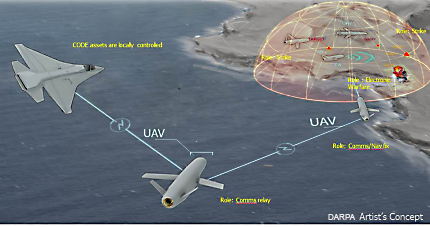Pentagon issues call for drones that hunt like a pack of wolves
DARPA is advancing its CODE program to develop collaborative autonomy for UAS.

Faced with increasing shortfalls for operations involving existing unmanned aircraft systems, commonly known as drones, the military has called on industry experts to help overcome chinks in the current UAS operational armor.
DARPA, the Defense Department’s research arm, has issued a special notice inviting interested and capable parties to participate in meetings aimed at “methodologies and approaches that are…focused on revolutionary approaches to unmanned aircraft systems (UAS) autonomy, and collaborative operations.”
The meetings will be held in collaboration with DARPA’s Collaborative Operations in Denied Environment (CODE) program, which seeks to make improvements in collaborative autonomy – a unique capability of futuristic autonomous warfare in which multiple UAS can work together under the direction of one operator. One advanced function under collaborative autonomy is the identification and engagement of targets with limited supervision from operators. All interested parties, DARPA noted, should be capable of providing methodologies and approaches within the scope of CODE’s research parameters.
“Just as wolves hunt in coordinated packs with minimal communication, multiple CODE-enabled unmanned aircraft would collaborate to find, track, identify and engage targets, all under the command of a single human mission supervisor,” DARPA program manager Jean-Charles Ledé said in a release. “Further, CODE aims to decrease the reliance of these systems on high-bandwidth communication and deep crew bench while expanding the potential spectrum of missions through combinations of assets—all at lower overall costs of operation. These capabilities would greatly enhance survivability and effectiveness of existing air platforms in denied environments.”
Researches within the CODE program currently are interested in a modular software framework that can work around bandwidth limitations and communications disruptions. However, the military wants to retrofit upgraded systems, meaning newer frameworks should be compatible with the existing platforms. The CODE program, initiated in early 2014, also is intended to overcome “challenges by developing algorithms and software that would extend the mission capabilities of existing unmanned aircraft well beyond the current state-of-the-art, with the goal of improving U.S. forces’ ability to conduct operations in denied or contested airspace,” according to the solicitation.
Despite a heavy reliance and overall satisfaction with the current ISR UAS model, DARPA outlined key challenges for the future. Such challenges include: limited autonomous reaction or adaptation to changes or situations mid-flight; the costs of enhancing survivability, which in some instances is impossible; tactical systems are working in isolation rather than working with nearby assets for navigation, off-board targeting, and communication; and lastly, the large crews necessary for UAS operation are expensive and are infeasible for quick reactions in dynamic situations.
The first meeting listed under DARPA’s special notice under first of three planned phases will be an Open Architecture meeting, where CODE team members will brief industry experts on their architecture plan and approach that includes real-time, segregated, multi-level security and operating system support. Industry experts will then offer feedback and insight for a framework the military can use going forward. The CODE team will also seek industry feedback on certain technical justifications for communication flows that can be adaptable and situationally-relevant to collaborative autonomy.
The second meeting, titled Technical Interchange, will aim to showcase certain technologies that could potentially be incorporated into a solution under Phases 2 and 3. CODE’s key objective is to ensure they are leveraging the best technologies available from the best industries.